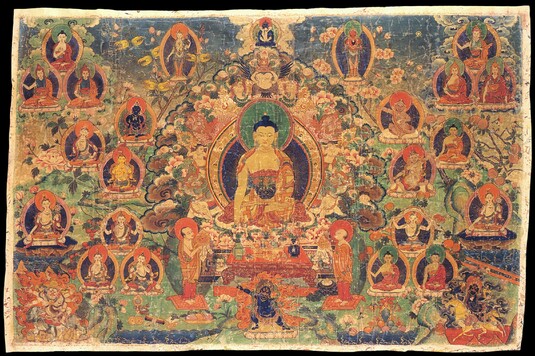
Item: Shakyamuni Buddha
| Origin Location | Tibet |
|---|---|
| Date Range | 1800 - 1899 |
| Lineages | Nyingma, Gelug and Buddhist |
| Material | Ground Mineral Pigment on Cotton |
| Collection | Private |
Classification: Person
Shakyamuni Buddha accompanied by the Twelve Dzogchen Buddhas of the Nyingma Tradition of Tibetan Buddhism.
Although the painting is clearly intended to depict a Nyingma iconographic program and subject, there are also Gelug compositional conventions and forms. Aside from the Twelve Buddhas, the unique and more recognizable Nyingma identifiers are images such as the depiction of Samantabhadra and Samantabhadri Buddha at the top center, the special four-armed Avalokiteshvara, in a standing posture, of the Longchen Nyingtig placed slightly to the top left and the appearance of the teacher Longchenpa on the far right. The three images at the bottom of the painting - Krodha Vajrapani, Tinle (activity) Pehar and Shri Devi Magzor Gyalmo - follow traditional Gelug compositional conventions.
Numbered List:
1. Shakyamuni Buddha
2. Shariputra
3. Maudgalyayana
4. Samantabhadra Buddha
5. Avalokiteshvara
6. Amitabha/Amitayus
7. Buddha
8. Teacher
9. Teacher
10. Teacher
11. Teacher
12. Longchen Rabjampa
13. Khasarpani Avalokiteshvara
14. White Tara
15. Dzogchen Buddha (numbered in yellow)
16. Dzogchen Buddha
17. Dzogchen Buddha
18. Dzogchen Buddha
19. Dzogchen Buddha
20. Dzogchen Buddha
21. Dzogchen Buddha
22. Dzogchen Buddha
23. Dzogchen Buddha
24. Dzogchen Buddha
25. Dzogchen Buddha
26. Dzogchen Buddha
27. Krodha Vajrapani
28. Tinle Pehar
29. Shri Devi Magzor Gyalmo
Jeff Watt 8-2011
Painting Type: Landscape Format & Subject
Collection: Private 1
Collection: Private 20
Buddhist Deity: Twelve Dzogchen Buddhas (Main Page)

